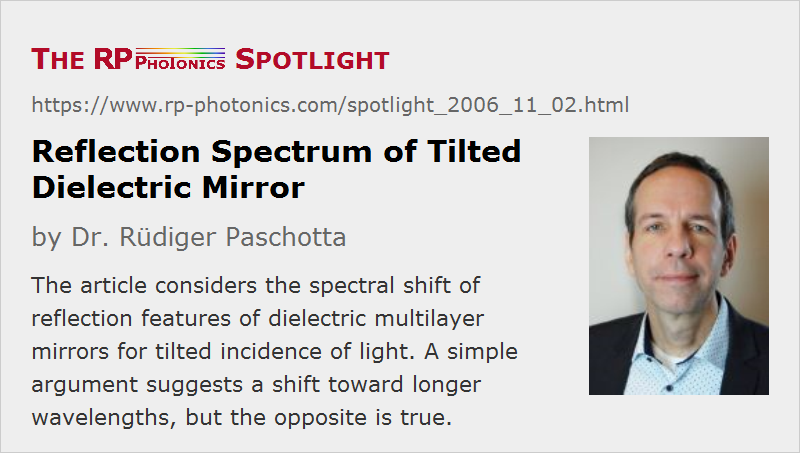Reflection Spectrum of Tilted Dielectric Mirror
Posted on 2006-11-02 as part of the Photonics Spotlight (available as e-mail newsletter!)
Permanent link: https://www.rp-photonics.com/spotlight_2006_11_02.html
Author: Dr. Rüdiger Paschotta, RP Photonics AG, RP Photonics AG
Abstract: The article considers the spectral shift of reflection features of dielectric multilayer mirrors for tilted incidence of light. A simple argument suggests a shift toward longer wavelengths, but the opposite is true.

Ref.: encyclopedia articles on laser mirrors and dielectric mirrors
Dielectric multilayer mirrors can be highly reflecting only in a limited spectral bandwidth. When such a mirror, designed for use with normal incidence of the light, is tilted against an incident beam, the reflection features are shifted toward shorter wavelengths.
At a first glance, one might actually expect the opposite effect, following the (flawed) argument that the optical path length between different layers of the mirror coating is increased, leading to a larger phase delay, which could be compensated by using a longer wavelength. So the reflection features should be shifted toward longer wavelengths – just the opposite of what is observed! What is wrong here?
A closer look shows where the above argument is wrong: following a ray from one layer to the next one under some angle, and back to the first layer along a “reflected” beam, we actually don't get back to the place where we started, but rather to some offset position. But it doesn't make sense to compare the phases of two beams as measured at two different positions!

For a correct argument, we have to consider e.g. two beams as reflected from two subsequent layer interfaces, and compare their phases at the same point. Doing this, we find that the phase delay actually becomes smaller for angled incidence. Another way to understand the issue is to consider the phase shift along a direction perpendicular to the coating layers. This can be calculated using the component of the k vector perpendicular to the surface. And the magnitude of that is obviously reduced for tilted incidence.
Reduced phase changes, as caused by an increased angle of incidence, can be compensated by using a shorter wavelength of light. So we understand why the reflection features of dielectric mirrors move towards shorter wavelengths when they are tilted against the input beam. See Figure 1 as an example.
This article is a posting of the Photonics Spotlight, authored by Dr. Rüdiger Paschotta. You may link to this page and cite it, because its location is permanent. See also the RP Photonics Encyclopedia.
Note that you can also receive the articles in the form of a newsletter or with an RSS feed.
Questions and Comments from Users
Here you can submit questions and comments. As far as they get accepted by the author, they will appear above this paragraph together with the author’s answer. The author will decide on acceptance based on certain criteria. Essentially, the issue must be of sufficiently broad interest.
Please do not enter personal data here; we would otherwise delete it soon. (See also our privacy declaration.) If you wish to receive personal feedback or consultancy from the author, please contact him, e.g. via e-mail.
By submitting the information, you give your consent to the potential publication of your inputs on our website according to our rules. (If you later retract your consent, we will delete those inputs.) As your inputs are first reviewed by the author, they may be published with some delay.


Connect and share this with your network:
Follow our specific LinkedIn pages for more insights and updates: